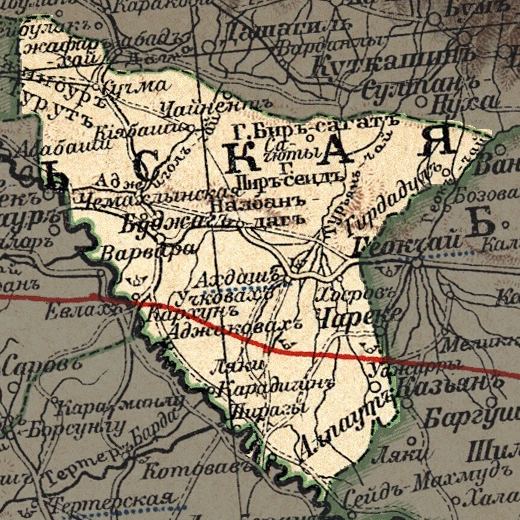Established 1874 Political status Uyezd Area 2,822.9 verst² | Abolished 1929 Region Caucasus | |
 | ||
Areshsky Uyezd (Russian: Арешский уезд) was one of the uyezds (administrative units) of Elisabethpol Governorate of the Russian Empire and then of Azerbaijan Democratic Republic with its center in Agdash from 1874 until its formal abolition in 1929 by Soviet authorities.
Contents
Geography
Elisabethpol Governorate consisted of Elisabethpol, Nukha, Shusha, Zangezur, Kazakh, Areshsky, Jabrayil and Javanshir Uyezds. Aresh uyezd was located in the northeastern part of Elisabethpol Governorate, on the banks of Kura River, bordering Baku Governorate on the east, Nukhinsky Uyezd on the north, Elisabethpol Uyezd on the west and Shusha Uyezd on the southwest. The area of the uyezd was 2822.9 square verst. The territory of the uyezd was mainly made up of lowlands. The uyezd center was first in Uchkovakh, then in Agdash which was considered the largest cotton-trading center in the lowlands of Transcaucasus.
History
The territory of Areshky Uyezd was located in the Turyanchay River basin. The area was called Aresh (Azerbaijani: Ərəş) in the Middle Ages and was a part of Shirvan Baylarbaylik which significantly weakened after repeated Ottoman - Safavid wars, and was eventually subdued by Shaki Khanate in 1750's. After establishment of Russian rule, Aresh was a part of Nukhinskiy Uyezd of Baku Governorate. In 1874, the territory was transferred into a separate Areshsky Uyezd of newly established Elisabethpol Governorate (1868). It was abolished by Soviet authorities in 1929 and a new Agdash Rayon was established in its place in 1930.
Population
According to census held in 1897, the population of uyezd was 67,277, of which 47,133 were Azerbaijani Turks, 13,822 were Armenians, 162 - Russians, and other minorities. The population was engaged primarily in agricultural farming and gardening. During summers, they would take the cattle to the mountains and return only in September. Wool production played an important role in the economy of uyezd.
